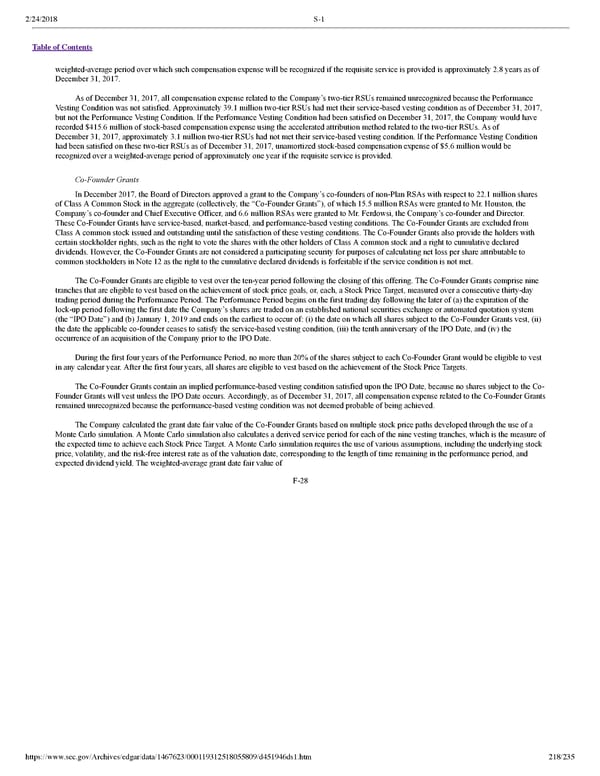2/24/2018 S-1 Table of Contents weightedaverage period over which such compensation expense will be recognized if the requisite service is provided is approximately 2.8 years as of December 31, 2017. As of December 31, 2017, all compensation expense related to the Company’s twotier RSUs remained unrecognized because the Performance Vesting Condition was not satisfied. Approximately 39.1 million twotier RSUs had met their servicebased vesting condition as of December 31, 2017, but not the Performance Vesting Condition. If the Performance Vesting Condition had been satisfied on December 31, 2017, the Company would have recorded $415.6 million of stockbased compensation expense using the accelerated attribution method related to the twotier RSUs. As of December 31, 2017, approximately 3.1 million twotier RSUs had not met their servicebased vesting condition. If the Performance Vesting Condition had been satisfied on these twotier RSUs as of December 31, 2017, unamortized stockbased compensation expense of $5.6 million would be recognized over a weightedaverage period of approximately one year if the requisite service is provided. CoFounder Grants In December 2017, the Board of Directors approved a grant to the Company’s cofounders of nonPlan RSAs with respect to 22.1 million shares of Class A Common Stock in the aggregate (collectively, the “CoFounder Grants”), of which 15.5 million RSAs were granted to Mr. Houston, the Company’s cofounder and Chief Executive Officer, and 6.6 million RSAs were granted to Mr. Ferdowsi, the Company’s cofounder and Director. These CoFounder Grants have servicebased, marketbased, and performancebased vesting conditions. The CoFounder Grants are excluded from Class A common stock issued and outstanding until the satisfaction of these vesting conditions. The CoFounder Grants also provide the holders with certain stockholder rights, such as the right to vote the shares with the other holders of Class A common stock and a right to cumulative declared dividends. However, the CoFounder Grants are not considered a participating security for purposes of calculating net loss per share attributable to common stockholders in Note 12 as the right to the cumulative declared dividends is forfeitable if the service condition is not met. The CoFounder Grants are eligible to vest over the tenyear period following the closing of this offering. The CoFounder Grants comprise nine tranches that are eligible to vest based on the achievement of stock price goals, or, each, a Stock Price Target, measured over a consecutive thirtyday trading period during the Performance Period. The Performance Period begins on the first trading day following the later of (a) the expiration of the lockup period following the first date the Company’s shares are traded on an established national securities exchange or automated quotation system (the “IPO Date”) and (b) January 1, 2019 and ends on the earliest to occur of: (i) the date on which all shares subject to the CoFounder Grants vest, (ii) the date the applicable cofounder ceases to satisfy the servicebased vesting condition, (iii) the tenth anniversary of the IPO Date, and (iv) the occurrence of an acquisition of the Company prior to the IPO Date. During the first four years of the Performance Period, no more than 20% of the shares subject to each CoFounder Grant would be eligible to vest in any calendar year. After the first four years, all shares are eligible to vest based on the achievement of the Stock Price Targets. The CoFounder Grants contain an implied performancebased vesting condition satisfied upon the IPO Date, because no shares subject to the Co Founder Grants will vest unless the IPO Date occurs. Accordingly, as of December 31, 2017, all compensation expense related to the CoFounder Grants remained unrecognized because the performancebased vesting condition was not deemed probable of being achieved. The Company calculated the grant date fair value of the CoFounder Grants based on multiple stock price paths developed through the use of a Monte Carlo simulation. A Monte Carlo simulation also calculates a derived service period for each of the nine vesting tranches, which is the measure of the expected time to achieve each Stock Price Target. A Monte Carlo simulation requires the use of various assumptions, including the underlying stock price, volatility, and the riskfree interest rate as of the valuation date, corresponding to the length of time remaining in the performance period, and expected dividend yield. The weightedaverage grant date fair value of F28 https://www.sec.gov/Archives/edgar/data/1467623/000119312518055809/d451946ds1.htm 218/235
 Dropbox S-1 | Interactive Prospectus Page 217 Page 219
Dropbox S-1 | Interactive Prospectus Page 217 Page 219